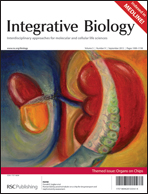Developing a human-on-a-chip by connecting multiple model organ systems would provide an intermediate screen for therapeutic efficacy and toxic side effects of drugs prior to conducting expensive clinical trials. However, correctly designing individual organs and scaling them relative to each other to make a functional microscale human analog is challenging, and a generalized approach has yet to be identified. In this work, we demonstrate the importance of rational design of both the individual organ and its relationship with other organs, using a simple two-compartment system simulating insulin-dependent glucose uptake in adipose tissues. We demonstrate that inter-organ scaling laws depend on both the number of cells and the spatial arrangement of those cells within the microfabricated construct. We then propose a simple and novel inter-organ ‘metabolically supported functional scaling’ approach predicated on maintaining in vivo cellular basal metabolic rates by limiting resources available to cells on the chip. This approach leverages findings from allometric scaling models in mammals that limited resources in vivo prompt cells to behave differently than in resource-rich in vitro cultures. Although applying scaling laws directly to tissues can result in systems that would be quite challenging to implement, engineering workarounds may be used to circumvent these scaling issues. Specific workarounds discussed include the limited oxygen carrying capacity of cell culture media when used as a blood substitute and the ability to engineer non-physiological structures to augment organ function, to create the transport-accessible, yet resource-limited environment necessary for cells to mimic in vivo functionality. Furthermore, designing the structure of individual tissues in each organ compartment may be a useful strategy to bypass scaling concerns at the inter-organ level.

You have access to this article
 Please wait while we load your content...
Something went wrong. Try again?
Please wait while we load your content...
Something went wrong. Try again?


 Please wait while we load your content...
Please wait while we load your content...